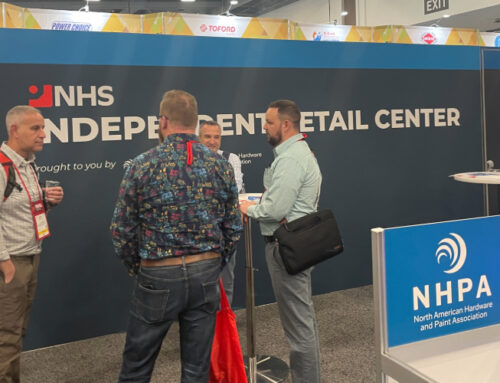For Craig Bond, current Paint and Decorating Retailers Association (PDRA) board president and owner of two Tommy’s Paint Pot stores in western Oregon, being an independent retailer doesn’t mean living in a bubble.
Sure, Bond is glad there isn’t a corporate office dictating his every move. He enjoys choosing inventory, creating marketing strategies, making staffing decisions and responding to the marketplace.
But Bond also understands that strong connections—with customers, suppliers, other retailers and the industry at large—are also important components of his success as an independent retailer. Like other independents, he has witnessed consolidation within the paint and decorating industry, as large conglomerates have absorbed retail operations of smaller and even equal size. Given these market realities, sometimes it’s not easy to go it alone.
“There’s a little, dark cloud that hangs over independent paint retailers. We see large chains gobbled up and multimillion-dollar companies taking over other multimillion-dollar companies. It’s grown to proportions where it’s hard to imagine where it ends,” Bond says. “It’s not as bad as it was 10 years ago, but there is still a cloud of fear over us, a fear that we could disappear.”
Bond suggests that one way independent retailers can combat this fear is to stay connected with an organization like the PDRA. “The PDRA is here to help, whether you’re an independent with two, 25 or 50 stores,” he says. “There are people at the PDRA who get up every day and try to find ways to help you.”
For an example of the PDRA’s assistance, Bond points to a new marketing program designed to help retailers compete. It includes QUARTERS consumer magazine, which retailers can distribute in their stores. “We’re trying to close the gap between stores and customers in ways that are meaningful,” Bond says. “And we’re leveraging it so retailers can have access to quality content with little expense and effort.” (Learn more about what QUARTERS can offer your operation on Page 63.)
Other PDRA tools include Paint & Decorating Retailer magazine, educational programming, a webinar series and more—all designed to help independent retailers compete more effectively.
Bond adds that paint stores face tough competitors whose main focus is to take away as much money as possible from independents.
“The goal at the PDRA is to figure out ways to make sure that doesn’t happen,” he says.
Proudly Independent

Photo by Jack Liu
Bond understands the needs of the independent paint retailer because he has been in the paint business nearly all of his life.
Bond’s father, Vern, worked most of his career at Miller Paint Co. Vern started with the company when he was 15 years old and retired in 1998 as executive vice president. Bond also started working at Miller Paint at age 15—first in the warehouse and then as a labeler and canner—and later worked at Miller Paint retail stores during college. From this vantage point, Bond says he watched the paint-making process from beginning to end.
“It was intriguing to me,” he says. After graduating in 1993 with a degree from Oregon State University in business administration, Bond took positions with Miller Paint stores in Portland, Tualatin and Beaverton, Oregon.
In 2002, Bond, his father and Bond’s brother-in-law, Roy, purchased Tommy’s Paint Pot, which at the time included two locations in Eugene. Tommy’s had a long history, a strong reputation and a loyal customer base, all of which attracted the new owners. The partners promptly did a little shuffling—opening a third store in Portland that same year and closing one of the Eugene locations the following year. In 2007, they moved the remaining Eugene store to its current location in a well-trafficked part of the city.
In 2012, Bond purchased a paint store in Salem, Oregon, where he opened another Tommy’s Paint Pot location. Adding a branch store had been part of the partners’ original business plan, but was delayed during the recession. Once the economy started to rebound, Bond revisited the idea again. “I thought I needed to move forward,” he says.
Bond says, however, that opening the Salem branch was stressful, largely due to challenges with the previous owner’s management practices. Over time, Bond and his Salem staff have corrected these problems and reconnected with former customers. Still, it’s been a challenge.
“One of the huge advantages that larger competitors have over independents is that they can open up another location far more easily and with a lot more resources,” Bond says. “But as a smaller retailer, your capabilities are stretched, and opening a second store is a big deal.”

Photo by Jack Liu
Throughout the changes, Tommy’s Paint Pot has found support from a loyal customer base that appreciates all an independent retailer has to offer. Many customers have continued shopping at the store for decades and through several owners. Currently, the customer base is 65 percent residential, 30 percent professional and 5 percent industrial.
As an independent, Bond feels a particular kinship with his professional customers. “I think the reason we’ve been able to establish and keep those relationships is that many of our professional customers are a lot like us,” Bond says. “We’re independent like they are, local like they are.”
While staff and painter discussions most often are about paint, Bond and his professional customers connect over the nature of their industry.
“Sometimes we have a conversation about how hard it is to find help or about issues we’re having with customers,” Bond adds. “And through these conversations, we find ways to help one another. It’s about the camaraderie.”
Fine Tuning
In addition to camaraderie, customers at Tommy’s Paint Pot find a broad and deep inventory. Currently, paint comprises 70 percent of the product mix; sundries, 27 percent; and window treatments, 3 percent. Window coverings are a more recent addition to the mix and include blinds, shades and motorization options. That part of the business is handled at the Eugene store by locally known colorist and designer Marcy Beard, who makes in-home visits upon request.

Photo by Jack Liu
Within this mix, products are well stocked, varied and, in some cases, hard to find elsewhere. “We work hard to have a broader range of products on the shelf for our customers to choose from,” Bond says. “We do the shopping for our customers, so they don’t have to.”
Though large, the inventory is well defined. Before stocking products, Bond’s employees test each one so they can make appropriate recommendations to customers. Additionally, employees listen carefully to customers to make sure the store carries the products they desire and in the quantities they need. “It’s hard to maintain a good, solid inventory,” Bond says. “But we make an attempt to listen to customers and adjust it to their benefit.”
By listening to customers, Bond has seen the value of hanging on to some products, even while retailers elsewhere have abandoned them. An example is MiniPots—3-ounce jars of sample paint color—which do well in this part of the environmentally conscious Pacific Northwest.
“Small-format samples have gone to the wayside in some stores, but we still offer them. Our customers seem to prefer them over a sample pint, which seems wasteful to them,” says Bond, who stocks the jars by the thousands. “Customers will start with paint chips then move to small-format samples. And then, if they’re still not sure, they will purchase a sample pint.”
At the Eugene location, MiniPots are displayed on wall shelves within the color center, which makes a dramatic presentation. The 10,000-square-foot store is not only sizeable, but also beautifully designed. It features well-organized product shelving and a designated 1,800-square-foot color decision area with an adjacent children’s play area.
The color center—Bond prefers the term “color showroom”—often elicits a “wow!” from first-timers to the store. Bond believes the area is one of his best marketing tools, and in the past, he has redirected advertising funds toward making it a standout.
It’s important for paint stores to play up their color capabilities, he says. “Customers make color decisions first, and then they talk about paint.”

Photo by Jack Liu
The Value of Connections
Customers are served at each location by a top-notch staff that includes eight employees in Eugene and three in Salem. Bond’s father, Vern, officially retired from Tommy’s Paint Pot in 2013, but continues to stop by from time to time.
Within his staff, Bond has been fortunate to keep a few long-timers, a testament to the value he places on connections. Bond is uncomfortable saying he has a secret for retaining good employees, but he tries to follow his own experiences in the paint industry.
“It’s a golden rule type of thing: I make an attempt to treat employees as I would either want to be treated or as I was treated as an employee by people I respected,” Bond says, noting that he also tries to tell his employees when they’re doing a good job. On this last note, past employers often dropped the ball. “I worked for a number of years before anyone came up and thanked me for doing a quality job,” Bond says. “That was impactful for me.”
The Tommy’s Paint Pot staff makes decisions every day that benefit the operation. The same can be said of Bond’s industry affiliations, which include not only the PDRA but also AllPro buying group. Consequently, Bond feels obligated to serve the industry when asked.
He knows firsthand the difficulty of finding volunteers. He served on a community board and was asked to recruit the next crop of directors, and he was turned down repeatedly.
“That’s when I became aware that people will find every reason in the book not to help out—not that they’re not good reasons. But it’s hard to find people,” Bond says. When Bond was asked to serve on the PDRA board, he quickly agreed. “It was a pretty easy ‘yes,’ ” he says.
Bond adds that he is glad to serve the PDRA, not only because it’s the right thing to do, but also because the organization does so much to support the independent retail channel.
“So, if it means sending in a PDRA dues check every year, I’ll do that. If it means serving on the PDRA board, I should say ‘yes.’ And if it means talking to a reporter from Paint & Decorating Retailer who wants to write an article on me, I should do that, too.”

Photo by Jack Liu







